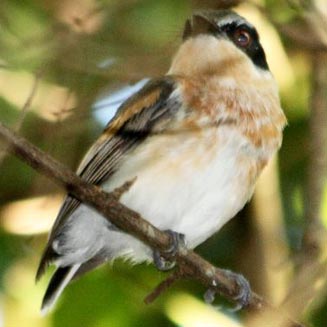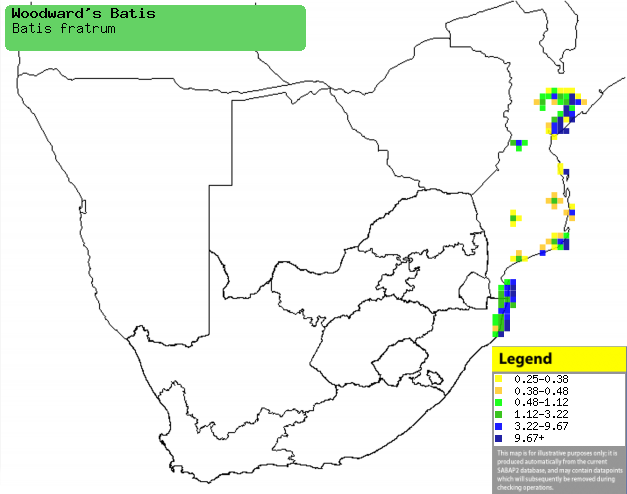|
Batis fratrum (Woodwards'
batis)
Woodwardse bosbontrokkie [Afrikaans];
Woodward-vliegenvanger [Dutch]; Pririt de Woodward [French]; Woodwardschnäpper
[German]; Batis de Woodward [Portuguese]
Life
> Eukaryotes >
Opisthokonta
> Metazoa (animals) >
Bilateria >
Deuterostomia > Chordata >
Craniata > Vertebrata (vertebrates) > Gnathostomata (jawed
vertebrates) > Teleostomi (teleost fish) > Osteichthyes (bony fish) > Class:
Sarcopterygii (lobe-finned
fish) > Stegocephalia (terrestrial
vertebrates) > Tetrapoda
(four-legged vertebrates) > Reptiliomorpha > Amniota >
Reptilia (reptiles) >
Romeriida > Diapsida > Archosauromorpha > Archosauria >
Dinosauria
(dinosaurs) > Saurischia > Theropoda (bipedal predatory dinosaurs) >
Coelurosauria > Maniraptora > Aves
(birds) >
Order: Passeriformes
> Family: Malaconotidae
 |
|
|
Woodward's batis female, Cape Vidal, iSimangaliso
Wetland Park, South Africa. [photo
Alan Manson
©] |
|
For information about this species, see
www.birdforum.net/opus/Woodward's_Batis
Distribution and habitat
Near-endemic to southern Africa, with populations scattered
across Mozambique bordering on Zimbabwe and north-eastern KwaZulu-Natal. It
generally prefers lowland and evergreen forest, as well as dense Acacia
woodland, sand forest, riparian forest and miombo (Brachystegia)
woodland.
|
 |
|
Distribution of Woodwards' batis in southern Africa,
based on statistical smoothing of the records from first SA Bird Atlas
Project (©
Animal Demography unit, University of
Cape Town; smoothing by Birgit Erni and Francesca Little). Colours range
from dark blue (most common) through to yellow (least common).
See here for the latest distribution
from the SABAP2. |
Food
It forages relentlessly throughout the day, catching
insects by gleaning them of twigs, leaves and branches, usually while hovering
in mid-air.
Breeding
- The nest is a loosely-constructed shallow cup, made of rootlets, tendrils,
fragments of dead leaves and sometimes lichen, bound together with strands
of spider web. It is usually placed amongst creepers or leaves, rarely in a
tree fork.
- Egg-laying season is from October-November.
- It lays 1-3 eggs, which are probably incubated solely by the female.
Threats
Not threatened.
References
-
Hockey PAR, Dean WRJ and Ryan PG 2005. Roberts
- Birds of southern Africa, VIIth ed. The Trustees of the John Voelcker
Bird Book Fund, Cape Town.
|
